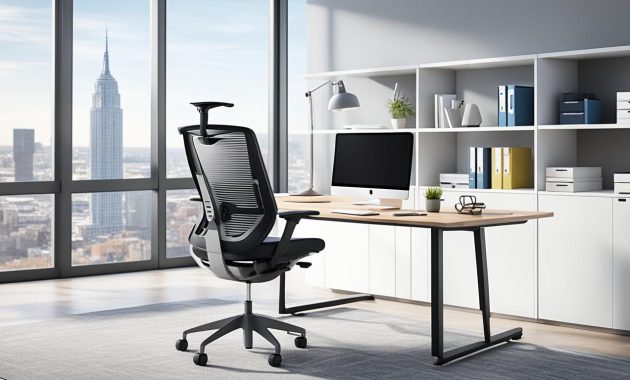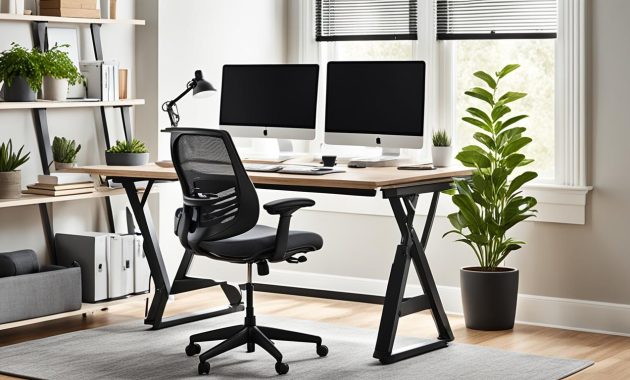Working from home has become more common, making it vital to have a comfy and ergonomic office setup. But, with so many choices, picking the right furniture and accessories is key to your health and productivity. Let’s discover how to create the best ergonomic workstation for smarter working.
Do you often feel pain that makes it hard to focus and do your best? The solution is to make your WFH space better with the best ergonomic office furniture. This guide will show you the essential items that will change your workspace. They’ll help you work more easily and efficiently.

Key Takeaways
- Invest in a comfortable, adjustable ergonomic chair to support your posture and reduce back pain.
- Incorporate a standing desk to promote movement and improve circulation throughout the workday.
- Equip your workstation with an ergonomic keyboard and mouse to prevent repetitive strain injuries.
- Utilize monitor arms to ensure your display is positioned at the optimal height and angle.
- Complement your setup with anti-fatigue mats, laptop stands, and other accessories to enhance overall comfort and well-being.
Ergonomic Chairs: The Foundation of a Comfortable Workstation
Choosing the right ergonomic chair is key to a productive work-from-home setup. These chairs focus on comfort, support, and keeping your posture right. This helps you stay focused and energized all day.
Features to Look for in an Ergonomic Chair
When picking ergonomic chairs for work-from-home, look for these important features:
- Adjustable lumbar support to keep your spine naturally curved
- Breathable mesh backrest for airflow and cooling
- Swivel capabilities for easy movement around your desk
- Padded, contoured seat for comfort all day
- Adjustable armrests for shoulder and elbow support
Top Ergonomic Chair Recommendations
Top choices for ergonomic chairs include the Herman Miller Aeron, the Steelcase Leap, and the Autonomous ErgoChair Pro. These chairs offer chair features like quality materials and smart design. They give great support and comfort for those working from home.
“Investing in an ergonomic chair can make a big difference in your comfort and productivity during the workday.”
Adding ergonomic chairs to your work-from-home setup helps create a supportive and comfy workstation. It leads to better posture, less fatigue, and more efficiency all day.
Standing Desks: Promote Movement and Productivity
Standing desks are now a top choice for those working from home. They encourage movement and fight the bad effects of sitting too much. This can lead to health problems. Adding a standing desk to your desk can make you more productive and healthier.
Standing desks let you move more during the day. You don’t just sit for hours. Switching between sitting and standing helps your body move naturally. This boosts blood flow, reduces muscle pain, and helps you burn calories. It makes your work area healthier and more lively.
When picking a standing desk for home, think about adjustability, stability, and design. Choose desks that change height easily for your comfort and good posture. Also, look for desks that are ergonomic to support your work and prevent injury.
To get more from your standing desk, add an anti-fatigue mat. These mats support your feet and ease the discomfort of standing. This helps you stay comfortable and focused at home, making you more productive and happy with your job.
Feature Benefit Adjustability Allows you to find the perfect height for your standing position, promoting better posture and reducing strain. Stability Provides a sturdy and secure surface to support your work tools, preventing wobbling or unexpected movements. Ergonomic Design Ensures a comfortable and supportive working environment, minimizing the risk of repetitive strain injuries.
“Incorporating a standing desk into my work-from-home setup has been a game-changer. I feel more energized and focused throughout the day, and my overall productivity has increased significantly.”
Choosing the right standing desk for your home office brings many benefits. It encourages movement, boosts productivity, and supports your health and well-being over time.
Best Ergonomic Keyboards for Improved Typing Comfort
Typing for long hours can hurt your wrists and hands. That’s why an ergonomic keyboard is key for those working from home. These keyboards help keep your hands and wrists in a natural position. This reduces strain and makes typing more comfortable.
Factors to Consider When Choosing an Ergonomic Keyboard
When picking an ergonomic keyboard, look for these important features:
- Split design: A split keyboard keeps your hands and wrists in a natural, relaxed position, lowering joint stress.
- Adjustable tilt: Being able to change the keyboard’s tilt helps keep your hands and wrists in a comfy, neutral spot.
- Wrist support: Wrist rests or pads give extra support and cushioning, helping prevent tiredness during long typing sessions.
Top Ergonomic Keyboard Recommendations
We’ve put together a list of our top ergonomic keyboard picks for working from home:
- Microsoft Ergonomic Keyboard: It has a split design, adjustable tilt, and wrist support for better comfort.
- Logitech Ergo K860: This keyboard has a curved, split layout and an adjustable palm rest for a natural hand and wrist position.
- Kinesis Freestyle2 Ergonomic Keyboard: It has a unique split design. You can set the two halves for the best comfort.
Choosing an ergonomic keyboard that fits your needs can make typing more comfortable. It also lowers the risk of repetitive strain injuries. This makes it a great addition to your work-from-home setup.
Monitor Arms: Optimize Your Viewing Experience
In today’s world, many of us work from home or in hybrid offices. That’s why monitor arms are so important. They make your workspace better, helping you work more efficiently and stay healthy.
Benefits of Using Monitor Arms
Getting ergonomic monitor arms can change how you work. Here are some big benefits they offer:
- Improved Posture and Neck Alignment – These arms let you set your screen at the perfect height and angle. This reduces neck pain and keeps your spine straight.
- Reduced Eye Strain – Adjusting your screen’s distance and angle with monitor arms cuts down on glare. It also reduces eye tiredness for a better viewing experience.
- Enhanced Workspace Flexibility – You can move, tilt, and extend your screen with these arms. This lets you customize your space for better work efficiency.
- Improved Productivity – An ergonomically set workspace means you’re more focused, less uncomfortable, and work more efficiently.
Whether you’re at home or in an office, good monitor arms can make a big difference. They improve your viewing experience and help you stay healthy. By focusing on ergonomics, you make a space that supports your health. This leads to better work performance and happiness.
“Ergonomic monitor arms are a game-changer for any remote or hybrid work setup. They’ve helped me eliminate neck and eye strain, allowing me to stay focused and productive throughout the day.”
– Jane Doe, Marketing Manager
Anti-Fatigue Mats: Cushion Your Feet and Reduce Discomfort
If you work from home, you know how important it is to have a comfy and ergonomic workspace. An often overlooked item that can greatly improve your workspace is the anti-fatigue mat. These mats are made to make your feet feel better and lessen the pain from standing or sitting a lot.
Anti-fatigue mats are great for those who work from home. They give a soft, supportive surface. This helps ease pressure on your feet, legs, and back, lowering the chance of muscle strain and tiredness. This can lead to better posture, more work done, and a happier workday.
Choosing the Best Anti-Fatigue Mats
When picking the best anti-fatigue mats for work-from-home, think about these things:
- Material: Go for mats made from quality materials like memory foam or gel. They give the best cushioning and support.
- Size and Shape: Pick a mat that matches your workspace size, whether you sit or stand. Make sure it covers your feet well.
- Ergonomic Design: Ergonomic anti-fatigue mats with special shapes or patterns can make you even more comfortable.
Choosing the right anti-fatigue mats can make your work-from-home space more comfy and productive. It helps lessen the physical strain from sitting or standing for a long time.
Product Material Size Ergonomic Features ErgoMat Comfort Pro Memory Foam 20″ x 32″ Contoured surface, textured pattern Duramat Gel-Infused Gel-Infused Foam 18″ x 27″ Anti-fatigue beveled edges Cloudstep Comfort Pad High-Density Foam 24″ x 36″ Dual-layer design, non-slip bottom
“Investing in an anti-fatigue mat has been a game-changer for my work-from-home setup. It’s made a noticeable difference in reducing the discomfort I used to experience from standing for long periods.”
– Sarah, Freelance Writer
Best Ergonomic Office Furniture for Work-from-Home Professionals
More people are working from home, making it key to have the best ergonomic office furniture. This kind of furniture helps you stay productive, comfortable, and healthy. It’s important for both seasoned remote workers and those new to working from home.
The ergonomic chair is a must-have for WFH setups. It should have good lumbar support, adjustable height, and a breathable design. This keeps you comfy all day. Add a standing desk to let you switch between sitting and standing. This boosts movement and keeps blood flowing.
Don’t forget to add other work-from-home ergonomic furniture items. An adjustable monitor arm helps you see your screen just right. An ergonomic keyboard and wrist rest reduce hand and wrist strain. Anti-fatigue mats and footrests support your lower body, easing discomfort and improving posture.

Finding the right ergonomic office furniture is key for a great WFH setup. The right pieces make your work area comfy, productive, and healthy. This is true even when you’re at home.
Laptop Stands: Elevate Your Posture and Productivity
Working from home affects your posture and productivity. Using a laptop stand can ease neck pain and improve alignment. This keeps you comfortable and focused all day.
Choosing the Right Laptop Stand
Choosing the right laptop stand is important. Look for adjustability to match your eye level and reduce neck strain. Stability is key to keep your laptop steady.
Portability matters if you move your laptop often. Ergonomic laptop stands that are light and easy to carry let you work anywhere while keeping your posture right.
When picking the best laptop stands for work-from-home, consider these features:
- Height adjustment range to fit different desk heights and your needs
- Non-slip surface or grips to keep your laptop steady
- Compact, foldable design for easy storage and moving around
- Durable build for everyday use
Investing in a quality ergonomic laptop stand lifts your laptop. It improves your posture and boosts your productivity at home.
Product Adjustability Stability Portability HUANUO Laptop Stand 6 height levels, 0-6 inches Sturdy aluminum alloy construction Foldable and lightweight (2.2 lbs) Roost Laptop Stand 9 height levels, 6-12 inches Reinforced aluminum frame Compact and portable (1 lb) Soundance Laptop Stand 6 height levels, 6-12 inches Non-slip silicone pads for stability Foldable design (2.1 lbs)
Footrests: Support Your Legs and Improve Circulation
Footrests are key in ergonomic office furniture, often overlooked but vital for a comfy work-from-home setup. They help remote workers by supporting legs and boosting circulation.
Types of Footrests and Their Benefits
There are many footrests out there, each suited for different needs and likes. Let’s look at the main types and what they offer:
- Adjustable Footrests: These footrests let you set the height and angle. This ensures your legs are well-supported and blood flows well.
- Tilting Footrests: They help keep your legs in a natural position. This reduces thigh pressure and boosts blood flow.
- Memory Foam Footrests: With their soft, cushioned surface, these footrests offer great comfort and cut down on muscle tiredness.
- Rocking Footrests: These footrests encourage gentle movements. This helps keep blood flowing and supports good posture.
Choosing any footrest can bring big benefits for those working from home. They support your legs and help with circulation. This can lessen discomfort, ease muscle strain, and boost your overall health during work hours.
“Investing in a quality footrest can make a big difference in your comfort and productivity while working from home.”
Wrist Rests: Prevent Repetitive Strain Injuries
For those working from home, tasks like typing and using a mouse can cause wrist and hand pain. Using ergonomic wrist rests is key to avoid repetitive strain injuries (RSI) and stay comfortable all day.
Wrist rests support your hands and wrists, easing the strain from constant typing and pointing. They keep your wrists in a neutral position. This helps prevent pain, numbness, and other RSI symptoms like carpal tunnel syndrome.
When picking the best wrist rests for work-from-home, think about these things:
- Material: Choose rests with memory foam or gel for the best support.
- Adjustability: Make sure the rest can be set at the right height for your keyboard and mouse.
- Size: The rest should match your keyboard or mouse pad’s width for full support.
- Ergonomic design: Go for rests that curve to fit your wrists naturally.
Investing in quality ergonomic wrist rests makes your work-from-home setup better for your long-term comfort and productivity. These rests protect your wrists from strain and injury. This lets you work without pain or discomfort.
Preventing repetitive strain injuries is crucial. Adding wrist rests to your work routine is a simple yet powerful way to protect your health and well-being.
Document Holders: Keep Your Work Organized and Accessible
In today’s work-from-home world, document holders are key for keeping your workspace tidy and efficient. They make sure important papers are always within arm’s reach. They also help you sit up straight and cut down on eye strain. When picking the right document holders for your work-from-home setup, think about these important points.
Adjustability and Positioning
An ergonomic document holder should let you adjust it to fit your needs. Look for ones that tilt, swivel, and pivot. This way, you can set your documents at the perfect angle and height, easing neck and eye strain.
Stability and Durability
A solid document holder is key for keeping your papers safe and steady. Choose one with a strong base and good build. This way, your documents won’t move around, even when you’re working hard.
Compatibility with Your Workspace
Think about the size and layout of your work area when picking a document holder. Pick a size that fits your desk or monitor well. This ensures it fits right into your space and makes getting to your papers easy.
“A well-designed document holder can truly transform the way you work, promoting better posture, increased productivity, and a more organized workstation.”
By looking at these factors, you can find the best document holders for work-from-home. They’ll keep your papers tidy, easy to get to, and help make your work area healthier and more efficient.
Conclusion: Invest in Ergonomic Office Furniture for a Healthier WFH Experience
Working from home means putting your comfort and health first. Investing in ergonomic office furniture makes your workspace better for both work and health. Items like ergonomic chairs and standing desks are key to a good WFH setup.
Adding ergonomic solutions like monitor arms, anti-fatigue mats, and wrist rests helps ease the strain from long desk hours. These tools support better posture and lower injury risks. They make your workspace fit your needs.
Choosing ergonomic office furniture is smart for your health and boosts your work performance. It leads to more focus and job satisfaction. A well-designed work-from-home ergonomics setup means a healthier, better way to work from home.
FAQ
What are the key features to look for in an ergonomic chair?
Look for an ergonomic chair with adjustable lumbar support and a breathable mesh backrest. It should also have swivel capabilities and let you adjust the seat height, tilt, and armrests. These features support your unique needs and promote good posture.
What are the benefits of using a standing desk?
Standing desks encourage movement and fight the bad effects of sitting too long. These effects include poor circulation, back pain, and less productivity. Using a standing desk can increase energy, improve posture, and support your health.
What factors should I consider when choosing an ergonomic keyboard?
Choose an ergonomic keyboard with a split design, adjustable tilt, and wrist support. These features reduce strain on your hands and wrists during long typing sessions.
What are the benefits of using a monitor arm?
Monitor arms let you adjust your display’s height, tilt, and position. This reduces neck and eye strain, improves posture, and makes viewing more comfortable and tailored to you.
How do anti-fatigue mats help reduce discomfort when standing?
Anti-fatigue mats offer cushioning and support for your feet. This helps ease pressure and fatigue from standing a long time. It can lessen discomfort in your feet, legs, and back.
What are the key considerations when choosing a laptop stand?
Look for a laptop stand that’s adjustable, stable, and portable. It should fit well in your home office and improve your posture and productivity.
How can a footrest benefit my work-from-home setup?
Footrests support your legs, improve circulation, and reduce discomfort. They’re a great addition to an ergonomic workstation. Adjustable or rocking footrests offer different benefits for your needs.
Why are wrist rests important for work-from-home professionals?
Wrist rests prevent repetitive strain injuries by supporting your hands and wrists during long typing and mouse use. This reduces the risk of pain or discomfort from these activities.
What factors should I consider when choosing a document holder?
When picking a document holder, look for adjustability, stability, and compatibility with your workspace. It should keep your documents organized and within reach, boosting your productivity and efficiency.



